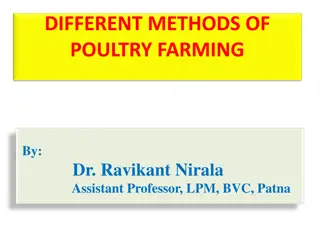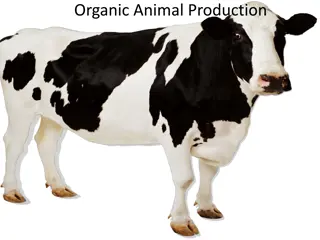Indigenous Technical Knowledge in Organic Farming: Sustainable Practices and Nutrient Management
Indigenous Technical Knowledge (ITK) plays a crucial role in organic farming by providing sustainable practices passed down through generations. Farmers in regions like Orissa, West Bengal, Tamil Nadu, and Rajasthan utilize ITK for nutrient management, intercropping, green manuring, and addressing agricultural challenges like iron toxicity. The eco-friendly and cost-effective nature of ITK promotes conservation and efficient utilization of resources, making it valuable for sustainable agriculture.
Download Presentation

Please find below an Image/Link to download the presentation.
The content on the website is provided AS IS for your information and personal use only. It may not be sold, licensed, or shared on other websites without obtaining consent from the author. Download presentation by click this link. If you encounter any issues during the download, it is possible that the publisher has removed the file from their server.
E N D
Presentation Transcript
Center for Smart Agriculture Organic Farming Module 3: Organic crop management Session 15: ITKs: Potential use in organic farming
ITK: Introduction The Indigenous Technical Knowledge (ITK) is regarded as the information gained over a period of time passed on from generation to generation by the word of mouth. ITK is the information base for a society, which facilitates communication and decision making. Indigenous information systems are dynamic, and are continually influenced by internal creativity and experimentation as well as by contact with external systems. ITK is stored in people's memories and activities, and is expressed in the form of stories, songs, folklore, proverbs, dances, myths, cultural values, beliefs, rituals, community laws, local language and taxonomy, agricultural practices, equipment, materials, plant species and animal breeds.
Experience and trial and error, tested in the rigorous laboratory of survival of local communities constantly reinforce indigenous knowledge. Of late, the policy makers, the scientific community and the extension workers started recognizing the value and importance of ITKs in agriculture. The inherent nature of ITKs prevent from over-exploiting natural resources, thus paving the way for sustainable agriculture. The basic characteristics of the ITKs provide for conservation and efficient utilization of resources by being eco-friendly, less capital intensive, cost-effective, and efficient by product and waste recycling and use.
ITKs used for nutrient management in paddy In jute rice rotation system of Orissa and West Bengal, farmers hardly use any fertilizer, only as basal dose to rice. After harvesting jute, farmers usually keep plants on their fields for about a week for their partial drying and shedding off all leaves on the ground. At the time of land preparation detached fallen leaves are incorporated into the soil and the field is kept as such for a week before transplanting rice seedlings. Decomposed jute leaves contribute at least 10-20 kg of N per hectare depending upon the yield of jute crop. For in situ manuring, weeds were allowed to grow on rice fields and then trampled at appropriate time. In large parts of Tamil Nadu, the spreading of wild shrub such as wild indigo (Wrightia tinctoria) and leaves of Pongamia pinnata and other trees are much used on wet lands, principally on rice fields. The fresh shrubs and leaves were spread on the fields and then trodden by feet. CONTD .
Intercropping Sesbania with Tomato during summer is found to enhance the yield of Tomato crop. Green manuring is practiced by planting trees like Karanj (pongamiaglabra) and using their leaf, or by sowing sesbania, crotalaria, green gram or Pillipesara in field and ploughing back into field to improve soil fertility. In Assam iron toxicity is a problem in some areas in rice ecosystem particularly in lowlands. The farmer s practice for controlling disorder involves walking down rice field or running down a paddy weeder between lines to facilitate aeration and to get ferrous iron oxidized to ferric iron. In Rajasthan the farmers allow to grow khejri trees (Prosopis cineraria) in rice fields. The trees and legumes are grown all over the crop fields. According to the farmers khejri brings up moisture and nutrients from underground soil for the crops grown above. The leguminous trees in rice fields also add nitrogen from the nitrogen fixing bacteria in their root nodules and green manure to the soil by their leaf fall.
Indigenous Technical Knowledge (ITK) related to weed management Before sowing, farmers sieve rice seeds in order to separate the seed of weeds. It is observed that some seeds are smaller and by sieving those will be filtered. Farmers irrigate the rice nurseries on the first day and they store the water for three-four days and even some farmers wait for one week. Then they plough the fields by turning the soil upside down .Again, they irrigate the nursery area and repeat the entire practice to check the weed growth in rice nursery. In traditional transplanted rice field water is stagnated during a long period of crop growth to manage the weed problem. Cultivation of sunhemp or dhaincha or cowpea as a green manure to control the nut grass (Cyperus rotundus) weed. Contd .
To check the growth of Aarai (Marsil eaquadrifolia) weed, Calotropis gigantea can be grown as a green manure. Seeds of Coriander are mixed with sorghum seed before sowing to completely control of Striga (parasitic weed). Allowing swine in the fields helps to eradicate nut grass. Involving pigs for burrowing the puddled fields and addition of tamarind husk complimented control of rice weeds especially nut sedge, which was reduced by 61 per cent. Keeping the irrigation channels clean reduces weed problem in the field. Farmers grow sunhemp in those fields where the motha (Cyperus sp.) weed is problem.























